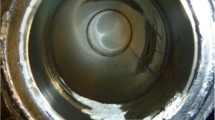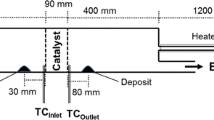Abstract
Ammonia-based selective catalytic reduction (SCR) systems are the most widely used technology for reduction of nitrogen oxide emissions from lean-burn engines such as diesel engines. However, at low exhaust temperatures, the SCR process is limited by difficulties in the decomposition of the ammonia precursor urea, which is carried on-board using an aqueous solution “AdBlue”. In this study, the decomposition of AdBlue urea induced by electrical current and the resulting associated pH shifts were investigated in a divided cell configuration in the liquid phase. The decomposition was found to be favored in both electrochemical compartments, anodic and cathodic, at temperatures of 60–80 °C compared to a reference without electrochemical treatment. In addition to the determination of ammonia contents using an ammonia sensor, IC/HPLC analyses were carried out for each sample. Different side products such as biuret, nitrate, cyanuric acid, ammelide, and others were formed. In the anodic compartment, nitrate formation could be observed due to oxidation of ammonia at the electrode surface.
Graphical abstract











Similar content being viewed by others
References
Li J, Chang H, Ma L, Hao J, Yang RT (2011) Catal Today 175:147
Rattalma M (2017) The Dieselgate. Springer, New York
Koch T (2018) Diesel-eine sachliche Bewertung der aktuellen Debatte. Springer, Wiesbaden
Tschöke H, Mollenhauer K, Maier R (2018) Handbuch Dieselmotoren. Springer, Wiesbaden
Kim YJ, Kwon HJ, Heo I, Nam IS, Cho BK, Choung JW, Cha MS, Yeo GK (2012) Appl Catal B-Environ 126:9
Neußer HJ, Kahrstedt J, Dorenkamp R, Jelden H (2013) Motortechnische Zeitschrift 74:440
Braun P, Gebhard J, Matysik FM, Rabl HP (2018) Chem Ing Tech 90:762
Johnson TV (2015) Int J Engines 8:1152
Guan B, Zhan R, Lin H, Huang Z (2014) Appl Therm Eng 66:395
Thirupathi B, Smirniotis PG (2012) J Catal 288:74
Wan Y, Zhao W, Tang Y, Li L, Wang H, Cui Y, Gu J, Li Y, Shi J (2014) Appl Catal B-Environ 148–149:114
Qiu L, Meng J, Pang D, Zhang C, Ouyang F (2015) Catal Lett 145:1500
International ISO-Standard: Diesel engines-NOx reduction agent AUS 32: ISO 22241-1:2006 (2006)
Bernhard AM, Peitz D, Elsener M, Schildhauer T, Kröcher O (2013) Catal Sci Technol 3:942
Hamada H, Haneda M (2012) Appl Catal A-Gen 421–422:1
Roppertz A, Füger S, Kureti S (2017) Top Catal 60:199
Blakeley RL, Treston A, Andrews RK, Zerner B (1982) J Am Chem Soc 104:612
Alexandrova AN, Jorgensen WL (2007) J Phys Chem B 111:720
Laidler KJ, Hoare JP (1950) J Am Chem Soc 72:2489
Panyachariwat N, Steckel H (2014) J Cosmet Sci 65:187
Lu F, Botte GG (2017) Electrochim Acta 246:564
Schranck A, Marks R, Yates E, Doudrick K (2018) Environ Sci Technol 52:8638
Singh RK, Schechter A (2018) Electrochim Acta 278:405
Boggs BK, King RL, Botte GG (2009) Chem Commun 32:4859
Ye K, Wang G, Cao D, Wang G (2018) Top Curr Chem 376:42
Senthilkumar N, Kumar GG, Manthiram A (2018) Adv Energy Mater 8:1702207
Zhu X, Dou X, Dai J, An X, Guo Y, Zhang L, Tao S, Zhao J, Chu W, Cheng Zeng X, Wu C, Xie Y (2016) Angew Chem Int Ed 55:12465
Koebel M, Elsener M (1995) J Chromatogr A 689:164
Bernhard AM, Czekaj I, Elsener M, Wokaun A, Kröcher O (2011) J Phys Chem A 115:2581
Peitz D, Bernhard AM, Mehring M, Elsener M, Kröcher O (2013) Chem Ing Tech 85:625
Bernhard AM, Peitz D, Elsener M, Wokaun A, Kröcher O (2012) Appl Catal B-Environ 115(116):129
Zheng G, Fila A, Kotrba A, Floyd R (2010) SAE Technical Paper 2010-01-1941
Strots VO, Santhanam S, Adelman BJ, Griffin GA, Derybowski EM (2010) SAE Int J Fuels Lubr 2:283
Trigueros PP, Sagues F, Claret J (1994) Phys Rev E 49:4328
Lin SH, Wu L (1996) Wat Res 30:715
Schaber PM, Colson J, Higgins S, Thielen D, Anspach B, Brauer J (2004) Thermochim Acta 424:131
Lecompte M, Obiols J, Cherel J, Raux S (2017) SAE Int J Fuels Lubr 10:864
Belson DJ, Strachan AN (1982) Chem Soc Rev 11:41
Author information
Authors and Affiliations
Corresponding author
Additional information
Publisher's Note
Springer Nature remains neutral with regard to jurisdictional claims in published maps and institutional affiliations.
Rights and permissions
About this article
Cite this article
Braun, P., Durner, B., Rabl, HP. et al. Investigations on the decomposition of AdBlue urea in the liquid phase at low temperatures by an electrochemically induced pH shift. Monatsh Chem 150, 1633–1641 (2019). https://doi.org/10.1007/s00706-019-02406-6
Received:
Accepted:
Published:
Issue Date:
DOI: https://doi.org/10.1007/s00706-019-02406-6




